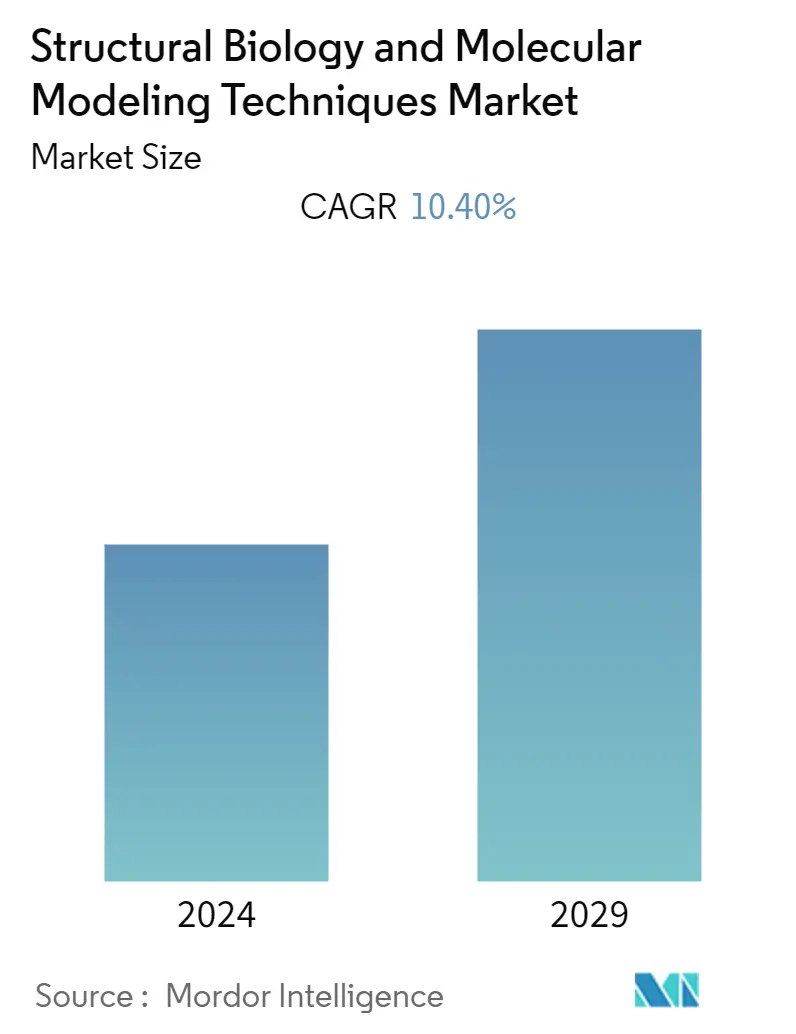Market Size of Structural Biology and Molecular Modeling Techniques Industry

| Study Period | 2019 - 2029 |
| Base Year For Estimation | 2023 |
| Forecast Data Period | 2024 - 2029 |
| CAGR | 10.40 % |
| Fastest Growing Market | Asia Pacific |
| Largest Market | North America |
Major Players
*Disclaimer: Major Players sorted in no particular order |
Need a report that reflects how COVID-19 has impacted this market and its growth?
Structural Biology & Molecular Modeling Techniques Market Analysis
The structural biology and molecular modeling techniques market is anticipated to register a CAGR of nearly 10.4% during the forecast period.
COVID-19 had a significant impact on the growth of the market. This was mainly due to the rising demand for the development of appropriate vaccination by understanding the molecular biology of SARS-CoV-2. For instance, the Nature Journal article published in January 2022 mentioned that structural biology can be used to study the pathogenic mechanism of viruses but also provides theoretical information for drug development and optimization. Such advantages provided by structural biology and molecular techniques are expected to drive the market's growth during the forecast period. Thus, COVID-19 had a profound impact on the growth of the market during the pandemic period. In addition, the demand for structural biology is expected to remain intact due to the emergence of a mutant strain of the SARS-CoV-2 virus and the increasing need for understanding the functioning of these mutant virus structures to develop appropriate treatments, thereby boosting the growth of the market over the forecast period.
Certain factors driving the market growth include technological innovations and advancements and the rising prevalence of chronic diseases. For instance, the British Heart Foundation (BHF) data published in January 2022 reported that in 2021, the most common heart conditions affected globally were coronary (ischemic) heart disease (global prevalence estimated at 200 million), peripheral arterial (vascular) disease (110 million), stroke (100 million) and atrial fibrillation (60 million). The report also mentioned that the prevalence of heart and circulatory diseases in North America was 46 million, in Europe 99 million, in Africa 58 million, in South America 32 million, in Asia and Australia 310 million. Additionally, according to the December 2021 report of the International Diabetes Federation (IDF), about 537 million adults of age 20-79 years were living with diabetes in 2021, and more than 90% of this population have Type 2 diabetes. As per the same source, the incidence of diabetes is expected to reach 643 million by 2030 and 783 million by 2040, and low- and middle-income countries were most affected by it. Also, it was estimated that about 541 million adults were at increased risk of developing Type 2 diabetes. Thus, the incidence of various chronic diseases is expected to drive the demand for structural biology and molecular modeling techniques to understand disease prevalence and develop appropriate treatments, thereby driving the market's growth over the forecast period.
Moreover, the increasing product launches by major market players to meet the growing demand for advanced structural biology and molecular modeling techniques contribute to the growth o the market. For instance, in July 2021, the London-based company Deep Mind released an open version source of its deep-learning neural network Alphafold2 and described its approach. It is software that accurately determines the 3D shape of proteins and is set to become widely available to scientists. Similarly, in January 2021, ComputaBio launched molecular dynamics simulation services for industrial and academic clients to better their capability for drug design and expedite drug development programs. Such launches of innovative software for drug development and the availability of molecular data are expected to drive the market's growth.
Thus the above-mentioned factors, such as the rising prevalence of chronic diseases and increasing launches of technologically advanced products, are expected to boost the market's growth during the forecast period. However, the lack of skilled professionals is expected to limit the market's growth during the forecast period.
